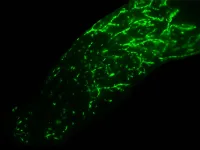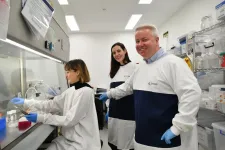(Press-News.org) New Haven, Conn. -- The ancient burrowers of the seafloor have been getting a bum rap for years.
These prehistoric dirt churners -- a wide assortment of worms, trilobites, and other animals that lived in Earth's oceans hundreds of millions of years ago -- are thought to have played a key role in creating the conditions needed for marine life to flourish. Their activities altered the chemical makeup of the sea itself and the amount of oxygen in the oceans, in a process called bioturbation.
But did that bioturbation help or hinder the expansion of complex animal life? A new Yale study, published in the journal Earth and Planetary Science Letters, found that seabed burrowers were very helpful indeed.
"Bioturbating animals are one of our foremost examples of 'ecosystem engineers,'" said lead author Lidya Tarhan, an assistant professor of Earth and planetary sciences at Yale. "They play a major role in shaping the chemical composition of the oceans, and even, on geologic time scales, the atmosphere."
Bioturbating animals that live and burrow in the sediments of the seabed first became widespread and active during the early Cambrian Period, about 541 million years ago. They were part of the so-called "Cambrian Explosion," when most animal groups with sophisticated body plans and behaviors began to appear in rapid succession, according to the fossil record.
But there is much debate among Earth scientists about what impact these burrowers had on their surroundings.
For example, there is the relationship between bioturbation and the availability of phosphorous -- a critical nutrient that is necessary for all life. The availability of phosphorous determines the size of the global biosphere and the complexity of life it can support. Phosphorous reaches the seafloor primarily in the form of plankton, whose carcasses sink to the bottom of the ocean after death, and from ocean waters that circulate upward along the margins of continents.
A large body of recent research has suggested that early burrowers took phosphorous and buried it, effectively choking off the supply of this life-creating nutrient. The theory also suggests that bioturbation changed the way carbon is buried under the ocean floor, leading to a widespread reduction of oxygen in the water.
A separate body of research about bioturbation -- grounded in evolutionary theory and observations from the fossil record -- offers a much different premise. This theory holds that seabed burrowing would have led to more biological sophistication, not less, in terms of animal size and behaviors.
"We've long had these two major camps of thinking, fundamentally at odds with each other, regarding the role of the earliest animals in shaping ocean chemistry, habitability, and ecology," Tarhan said.
The Yale team's new work aims to resolve the matter.
For the study, Tarhan and her colleagues created new models of phosphorous cycling and bioturbation that more accurately depict both processes. For example, she said, earlier models did not account for the large amount of phosphorous-rich minerals that form in sediment on the ocean floor. Likewise, previous modeling assumed that bioturbation was an all-or-nothing activity that operated almost like an on-off switch, rather than a behavior that ramped up gradually.
"Our work has, for the first time, reconciled the two major frameworks regarding the role of early animals in driving changes in the evolutionary and biogeochemical landscapes of Earth's early oceans," Tarhan said. "Early burrowing animals did indeed foster the emergence of increasingly productive and complex ecosystems and helped further the Cambrian explosion, rather than stifling or delaying its impact."
INFORMATION:
Co-authors of the study are Noah Planavsky, an associate professor of Earth and planetary sciences at Yale, and Mingyu Zhao, a former postdoctoral researcher at Yale who is now at the University of Leeds.
New Haven, Conn. -- When San Francisco voters overwhelmingly approved a ballot measure banning the sale of flavored tobacco products in 2018, public health advocates celebrated. After all, tobacco use poses a significant threat to public health and health equity, and flavors are particularly attractive to youth.
But according to a new study from the Yale School of Public Health (YSPH), that law may have had the opposite effect. Analyses found that, after the ban's implementation, high school students' odds of smoking conventional cigarettes doubled in San Francisco's school district relative to trends in districts without the ban, even when adjusting for individual demographics and other ...
This new 3D effect can be the foundation for topological quantum phenomena, which are believed to be particularly robust and therefore promising candidates for extremely powerful quantum technologies. These results have just been published in the scientific journal Nature Communications.
Dr. Tobias Meng and Dr. Johannes Gooth are early career researchers in the Würzburg-Dresdner Cluster of Excellence ct.qmat that researches topological quantum materials since 2019. They could hardly believe the findings of a recent publication in "Nature" claiming that electrons in the topological metal zirconium pentatelluride (ZrTe5) move only in two-dimensional ...
WHAT:
An environment in which family members support one another and express their feelings can reduce the effects of social deprivation on cognitive ability and development among adopted children, suggests a small study by researchers at the National Institutes of Health. In contrast, rule-driven households where family members are in conflict may increase an adopted child's chances for cognitive, behavioral and emotional difficulties.
The study was conducted by Margaret F. Keil, Ph.D., and colleagues in the Section on Endocrinology and Genetics at NIH's Eunice Kennedy Shriver National Institute of Child Health and Human Development (NICHD). It appears in Pediatric Research.
Researchers enrolled children who had spent at least eight ...
An analysis led by North Carolina State University researchers found counties with more socially vulnerable populations had a higher density of natural gas pipelines overall.
The findings suggest counties that are more socially vulnerable are also at greater risk of facing water and air pollution, public health and safety issues, and other negative impacts associated with the pipelines.
"We know that the network, as it stands today, is already distributed in such a way that any negative impacts fall disproportionately on vulnerable communities," ...
Hormonal contraceptives, e.g. the pill, the patch, and the vaginal ring, contain synthetic hormones that prevent pregnancy by either stopping ovulation, changing the cervical mucus to stop sperm from passing through the cervix and finding an egg, or changing the womb's lining to prevent a fertilized egg from being implanted in it.
Despite their widespread use, hormonal contraceptives are known to increase the risk of breast cancer, which is the most common cause of cancer-related death among women worldwide, and also topped the list of most commonly diagnosed cancers in 2020.
The main component of hormonal contraceptives are progestins, ...
Anesthesia may be an exact science, but it's not yet fully personalized. Anesthesiologists use a variety of methods to calculate the right dose for a given patient: clinical studies, medical databases and laboratory measurements, for example. However, every individual responds to anesthetics in a different way, and there's no way of knowing what that response will be until the anesthetic is administered.
Personalizing dosage
Today patients often receive supplemental doses of an anesthetic during their operation based on their reaction. The role of anesthesiologists is to make sure that a patient doesn't wake up too soon and has no memory of the procedure, but they must use ...
Scientists from the Wellcome Sanger Institute and the University of Cambridge found that in children with neuroblastoma - a cancer of immature nerve cells - treatment with platinum chemotherapy caused changes to the genome that could then cause leukaemia in some children later on.
The findings, published 27th May 2021 in Blood could lead to an ability to identify which children are more likely to develop the secondary cancer. This in turn could lead to changes in their treatment plan to either avoid these risks or take measures to prepare.
Secondary blood cancer is a challenging complication of childhood neuroblastoma cancer treatment. Every year around 100 children in the UK are diagnosed with neuroblastoma*, ...
The group of experts includes Professor and Academician of Tallinn University of Technology Jarek Kurnitski, who said that improving ventilation can be regarded more broadly as a paradigm shift equal in scale to the transformation in the standards of drinking water supplies and food hygiene. "There has long been no doubt that you can get infection when you drink water or eat food that has been contaminated. Now we must work towards providing clean air so we can breathe safely," Kurnitski said.
He added, "Researchers see updating of ventilation standards, ventilation requirements based on the probability of infection and more efficient and flexible ventilation systems as a solution. High air change rates are required only in the event of an epidemic, at any ...
Varying immune response to vaccinations could be countered with microbiota-targeted interventions helping infants, older people and others to take full advantage of the benefits of effective vaccines, Australian and US experts say.
A comprehensive review in Nature Reviews Immunology concludes that evidence is mounting in clinical trials and other studies that the composition and function of individuals' gut microbiota are "crucial factors" in affecting immune responses to vaccinations.
"Never before has the need been greater for robust and long-lasting immunity from our vaccination programs, particularly in low and middle-income countries, and for populations at increased ...
Researchers at the University of Adelaide are concerned video sharing platforms such as YouTube could be contributing to the normalisation of exotic pets and encouraging the exotic pet trade.
In a study, published in PLOS ONE, researchers analysed the reactions of people to videos on YouTube involving human interactions with exotic animals and found those reactions to be overwhelmingly positive.
The researchers analysed the reactions - via text and emoji usage - in comments posted on 346 popular videos starring exotic wild cats and primates in 'free handling situations'.
These situations involved exotic animals interacting with humans or other animals, such as domestic cats and dogs. The videos examined received ...



